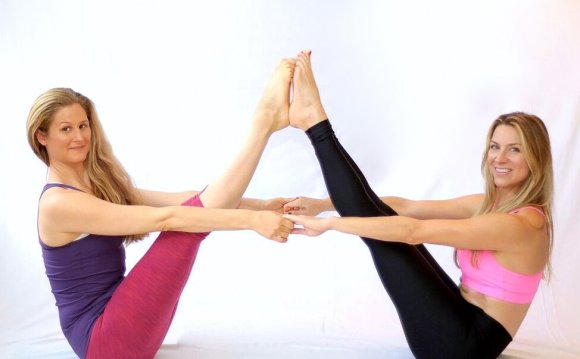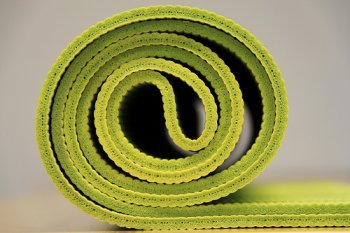
 Students often ask me what the best yoga mat to buy is so I thought I would just write it down for you here. Remember, this is solely my opinion, but I hope that it gives you some insight and guidance during your next yoga mat purchasing decision.
Students often ask me what the best yoga mat to buy is so I thought I would just write it down for you here. Remember, this is solely my opinion, but I hope that it gives you some insight and guidance during your next yoga mat purchasing decision.
A quick note about price: You can buy yoga mats at fitness stores and bookstores and even online for cheap. Or you can dole out almost $100. The difference is quality. If you are a serious yoga practitioner with a consistent practice, invest in an expensive mat. If you’re just dabbling, or if you don’t have a strenuous practice, the one from Target will do you just fine.
The other thing to consider is toxicity. Some yoga mats are made with plastics that are known to be toxic substances (PVC). Do you want to breathe in toxins while you’re trying to get healthy? That’s up to you. Investing in a good quality mat will not necessarily help you avoid the bad stuff. Make sure you read your labels and do your research ahead of time if this is important to you because high price does not always mean safe materials and conscious manufacturing.
Also, the word “eco” in front of anything doesn’t mean anything. When you dig a little deeper, you’ll often find that the mat is free of one toxic substance but not all, it’s made with a “toxin-free manufacturing process” but the materials are still toxic, or my favorite – the toxins are “eco-certified.” This industry is unregulated – the companies don’t have to tell you what they make their mats out of and their are no restrictions. So just beware. Unfortunately in my experience, the toxin-free mats just don’t hold up like the cancerous ones.
My Favorite
As much as I don’t want it to be, Lululemon’s “The Mat” is the best option for me. As a Power Vinyasa student who practices in heat, I need a yoga mat that is both sticky and smooth for ease of movement. At first glance, you might think “The Mat” is a horrible choice for non-slippiness because of it’s smooth surface, but don’t be fooled. It works.
Also, everyone who practices Power Vinyasa in heat will need a mat that helps them avoid slipping. To date, I have never found a mat that I didn’t slip on when sweating profusely. That’s why they invented yoga towels, which are ridiculously overpriced, but necessary all at the same time.
Toxicity watch: This mat is coated with Polyurethane – a known respiratory toxin.
What’s it going to cost you? $68
Another Popular Option
Many people like the Manduka mat. I’ve never personally practiced on one but I have picked one up and those things are heavy! If you plan to carry your mat around with you all day before heading to class, this might not be the best option. It’s certainly durable though. They have a bunch of different versions of the mat but the Black Pro is their classic, no-frills standard.
Toxicity watch: These mats are made with “eco-certified” PVC and polyester. I don’t know what that means, but PVC is PVC even if you put the words “eco-certified” in front of it.
What’s it going to cost you? Depending on thickness, color, version, etc., you’re looking at anywhere between $48-$360. Why anyone would ever pay $360 for a yoga mat, I’m not sure. Most likely, you’ll spend around $100 with Manduka.
Eco-Hip
Jade Yoga Mats prides itself on being eco-friendly. Once again, I’ve never persaonlly owned a Jade, but I do know and respect teachers that love them. I’ve had on experience with eco-friendly yoga mats and it wasn’t great. It wasn’t a Jade either, so I can only hope that Jade’s eco-friendly mats don’t disintegrate on you.
Toxicity watch: Jade’s mats are made of natural rubber instead of PVC, which naturally gives them that rubbery smell. If it doesn’t bother you, great. If it does, just beware.
What’s it going to cost you? Depending on thickness and color anywhere between $69.95-$104.
The Target Special
Gaiam yoga mats are most beginner’s best friends. They are inexpensive and functional, but they’re not really anything special (despite the heading). In recent years, Gaiam has come out with new lines of more luxurious mats, which is cool, but they struggle to be thought of as anything more than a beginner’s yoga mat or the “cheap” option. I will say there is nothing cheap about these mats. I own a few and they do last a while. I’ve gone through 2 full rounds of P90X on one and they are the stickiest versions around in my opinion. When it comes to performance in a hot yoga class though, they aren’t your best friend.
Toxicity watch: Made with PVC.
What’s it going to cost you? $21.98 or around $30 for a whole kit of things, including DVD’s and maybe a few other props.
The Blanket Option
For those of you who are truly concerned about the toxicity level of mats, blankets are the best option to avoid pesky PVC and environmental toxins. However, blankets don’t work so well in a Power Yoga class. If your practice tends to be more restorative and gentle, than a blanket can be a great option. Just don’t expect to hold too many Downward Facing Dogs on one. Check out Yoga Accessory store Hugger Mugger for blanket options.
Toxicity watch: Who knows how toxic Mexican wool is – but my guess is it’s better than PVC?
What’s it going to cost you: $34.95-$49.95
Other places you can buy yoga mats
The following options range from the yoga accessory outlets where studios go to get there props in bulk, to your local sporting goods store, to the more upscale yoga apparel stores that have also designed and manufactured their own mats. Remember to do your research on what the mat is made of!
- Any sporting goods store, which will probably carry a Reebok brand or some other sports line
- Kulae – another company that focuses solely on eco-mats. They say their mats are free of pthalates, which is great, but they don’t say anything immediately about PVC.









